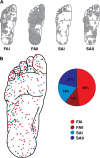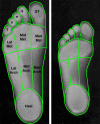Cutaneous afferent innervation of the human foot sole: what can we learn from single-unit recordings?
- PMID: 29873612
- PMCID: PMC6171067
- DOI: 10.1152/jn.00848.2017
Cutaneous afferent innervation of the human foot sole: what can we learn from single-unit recordings?
Abstract
Cutaneous afferents convey exteroceptive information about the interaction of the body with the environment and proprioceptive information about body position and orientation. Four classes of low-threshold mechanoreceptor afferents innervate the foot sole and transmit feedback that facilitates the conscious and reflexive control of standing balance. Experimental manipulation of cutaneous feedback has been shown to alter the control of gait and standing balance. This has led to a growing interest in the design of intervention strategies that enhance cutaneous feedback and improve postural control. The advent of single-unit microneurography has allowed the firing and receptive field characteristics of foot sole cutaneous afferents to be investigated. In this review, we consolidate the available cutaneous afferent microneurographic recordings from the foot sole and provide an analysis of the firing threshold, and receptive field distribution and density of these cutaneous afferents. This work enhances the understanding of the foot sole as a sensory structure and provides a foundation for the continued development of sensory augmentation insoles and other tactile enhancement interventions.
Keywords: NEWS & NOTEWORTHY We present a synthesis of foot sole cutaneous afferent microneurography recordings and provide novel insights about the distribution; and firing characteristics of cutaneous afferents across the human foot sole. The foot sole is a valuable sensory structure for the control of standing balance; and our findings provide a new understanding on how the foot sole can be viewed as a sensory structure; cutaneous afferents; density; foot sole; mechanoreceptor; microneurography; tactile feedback.
Figures






References
Publication types
MeSH terms
LinkOut - more resources
Full Text Sources
Other Literature Sources
Medical

